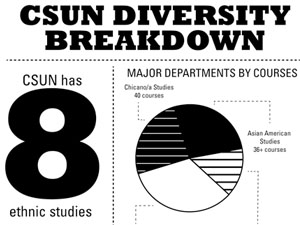 After breaking ground by founding the nation’s first Central American studies program and one of the first Chicana/o studies programs, CSUN continues to have one of the largest and most diverse selection of ethnic studies programs in the California State University system.
After breaking ground by founding the nation’s first Central American studies program and one of the first Chicana/o studies programs, CSUN continues to have one of the largest and most diverse selection of ethnic studies programs in the California State University system.
CSUN boasts a number of major and minor options in programs that include American Indian, Jewish, Central American, Middle Eastern and Islamic, and Russian studies. CSUN also offers separate departments for Asian American, Chicana/o and Pan African studies.
Compared with other CSU’s with an average of more than 33,000 students, including Long Beach State, Cal State Fullerton, San Diego State, San Francisco State, and San Jose State, CSUN has eight ethnic studies programs and departments with both CSULB and SDSU trailing not too far behind, with seven ethnic studies programs and departments. San Jose ranks the lowest with only two ethnic studies departments.
The CSUN community is known to pride itself on its diversity which was reflected on by campus president, Dr. Dianne Harrison, in a letter to the campus community shortly after her arrival in 2012.
In the letter, Harrison noted the “depth of (CSUN’s) diversity” and the history of activism during the civil rights movement, which was the catalyst in the founding of the Chicana/o studies and Pan African studies programs.
Despite years of federal and state budget deficits and subsequent budget reductions in education, CSUN’s well-established ethnic studies programs were affected. However, they continued to provide students with a healthy number of courses in their curriculums.
The Asian American studies program is second largest in the CSU system, after San Francisco State, with more than 36 courses. Central American studies is the largest nationwide with 20 courses. Pan African studies offers 59 courses, and Chicana/o studies program offers approximately 40 courses.
According to data provided by CSUN’s Office of Institutional Research, the CSUN “minority” population now constitutes more than half the school’s student population. Minority students constitute approximately 19,000 of the school’s 36,000 students, an increase of more than 51% since 1993.
“The efforts to construct these spaces of solidarity and companionship among the ethnic studies programs is important for students because they are very diverse and reflect the CSUN population,” said Dr. Beatriz Cortez, professor of Central American studies, director of the Central American Research And Policy Institute, and co-author of the book Introduction to Central American Studies.
Central American studies is the fastest growing ethnic studies program at CSUN. It continues to expand as does the Central American student population.
Out of CSUN’s approximately 12,000 Latina/o students, the largest ethnic population on campus, approximately 4,000 are Central American, said Dr. Douglas Carranza, chair of the Central American studies program.
“The program is growing tremendously and we will need even more material and human resources,” Carranza said. “The demand is there from the larger student population, because Los Angeles has a growing Central American population who will be demanding services, so students in professions like health care, journalism, and education will need knowledge of the Central American culture to perform their jobs.”
CSUN’s students and faculty have stood in solidarity with other schools whose ethnic studies programs were at risk.
In 2011, students and faculty protested alongside those at Cal State L.A., against the suspension of their Asian American studies program due to what the administration said was low enrollment.
In 2012, CSUN students traveled to Tucson to protest the ban against Mexican American studies, which was recently upheld in a federal court and which supporters claim promotes ethnic solidarity while fostering racial resentment.
“The idea of social justice is important in the learning of ethnic studies,” said Dr. Gina Masequesmay, chair of the Asian American studies department. “It helps students connect with other minority groups and helps them understand their own identity and how it plays out in the larger racial narrative.”





